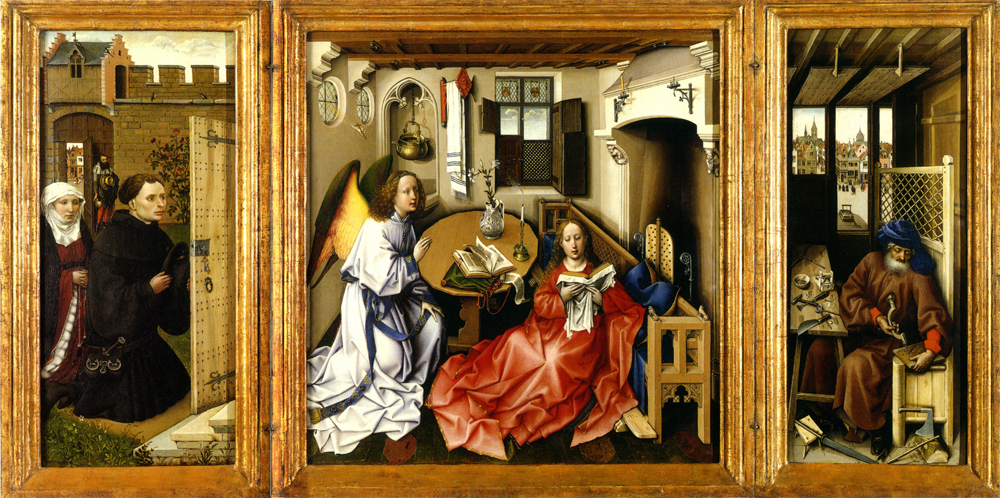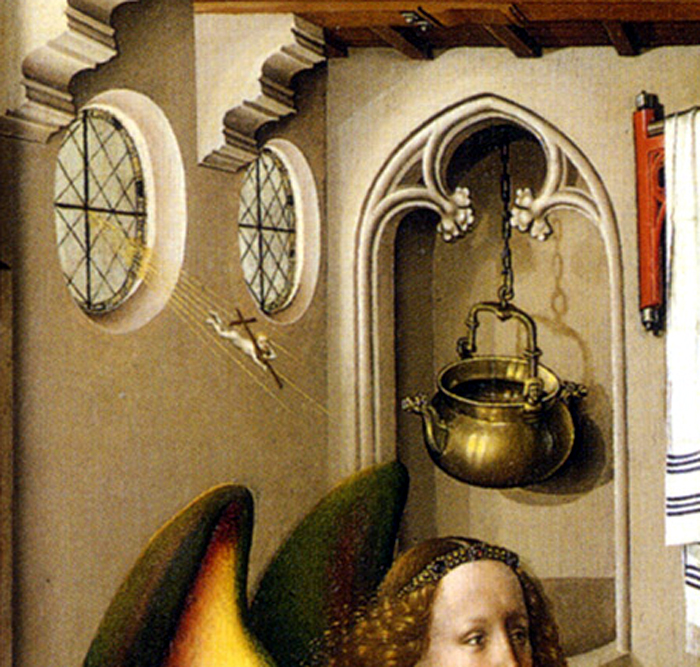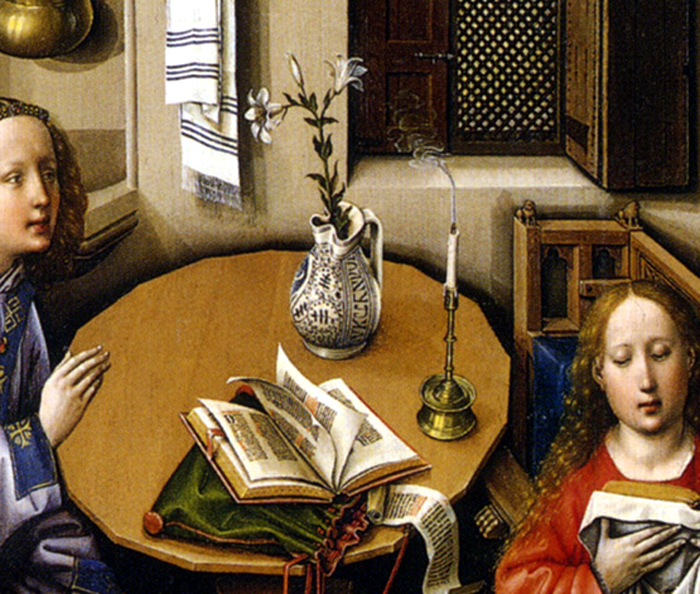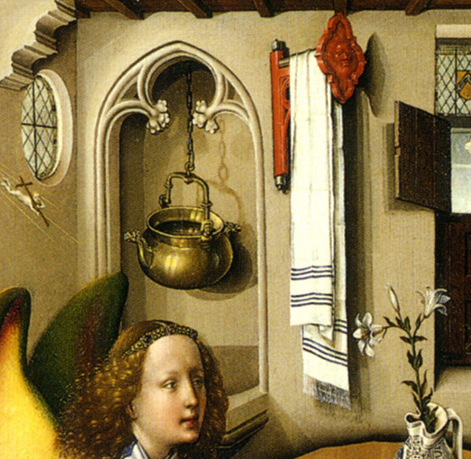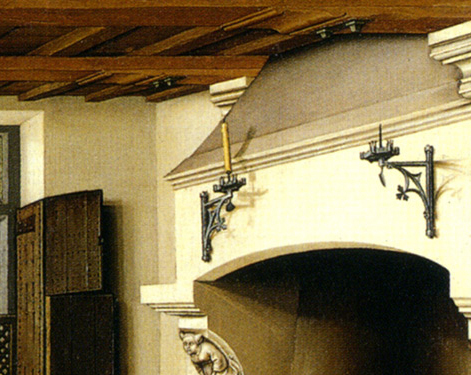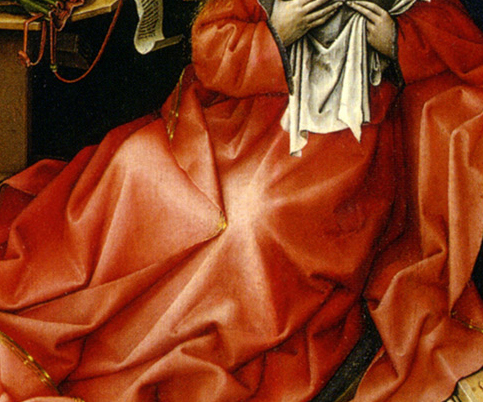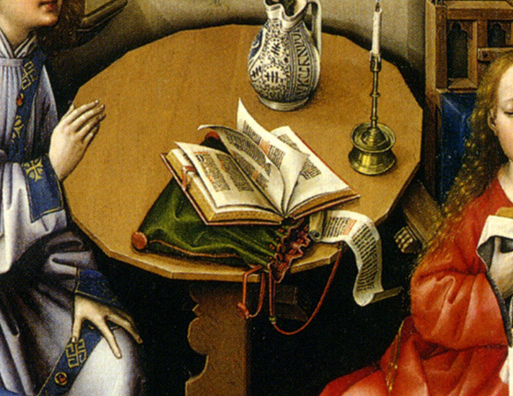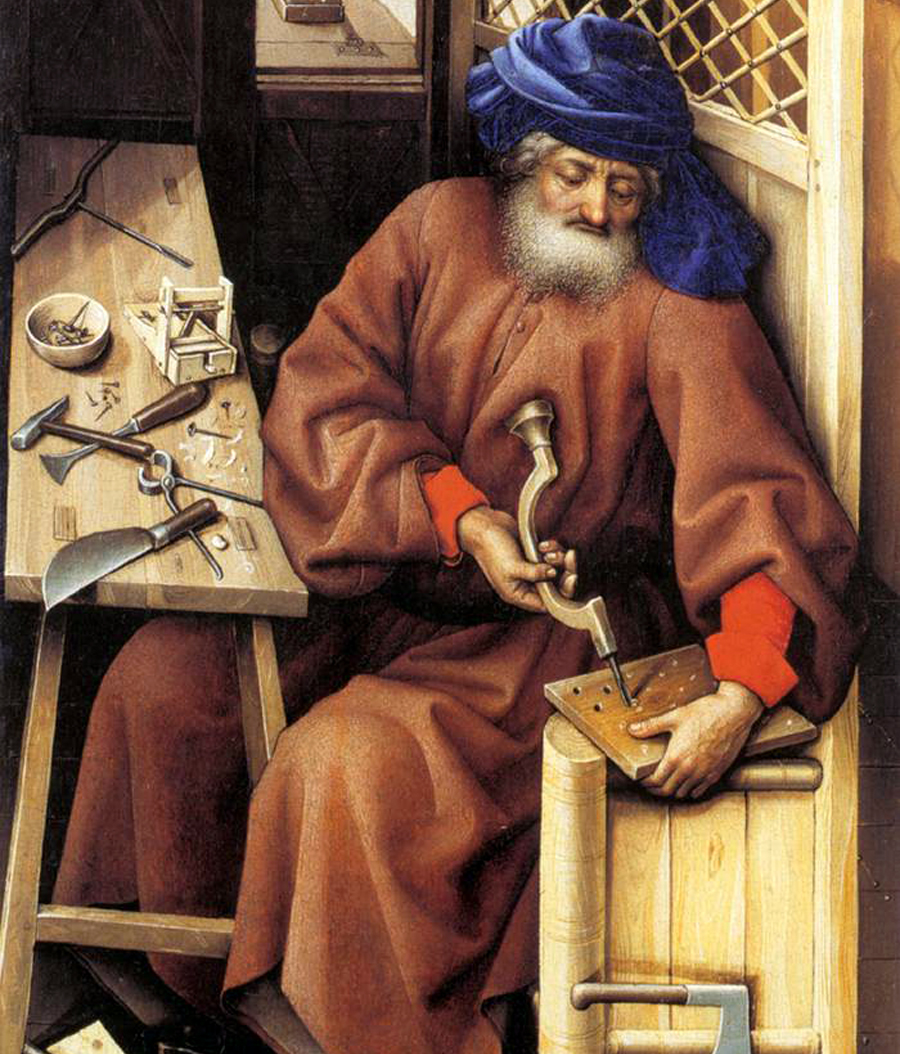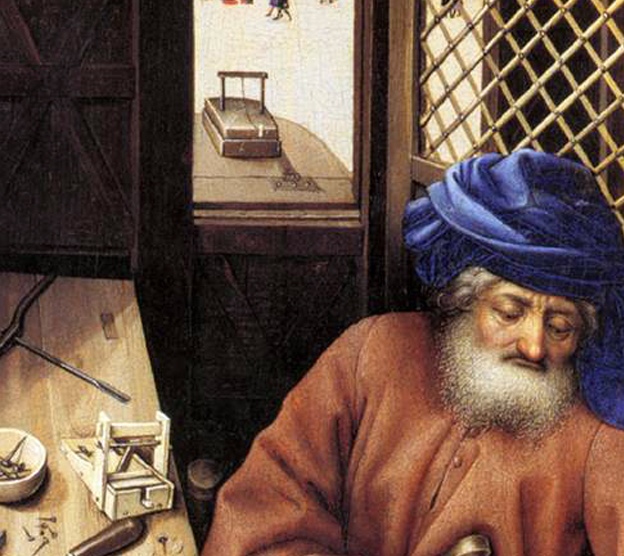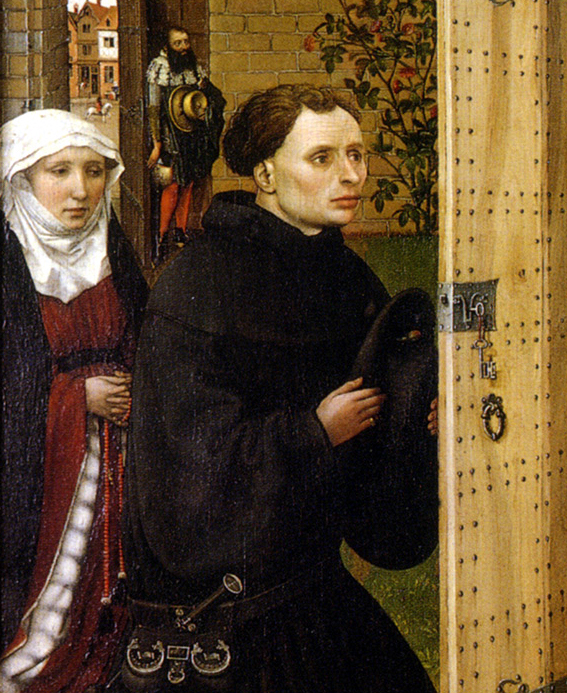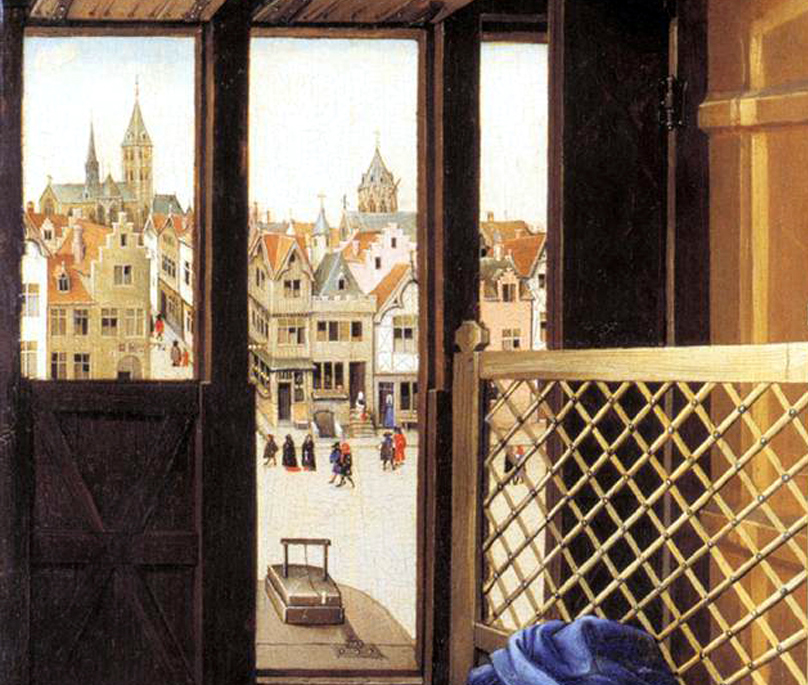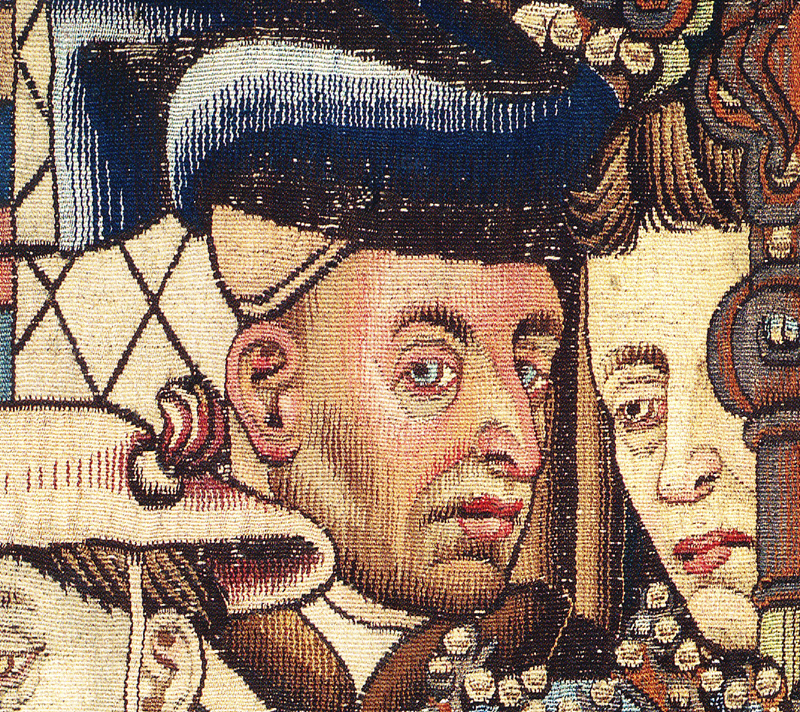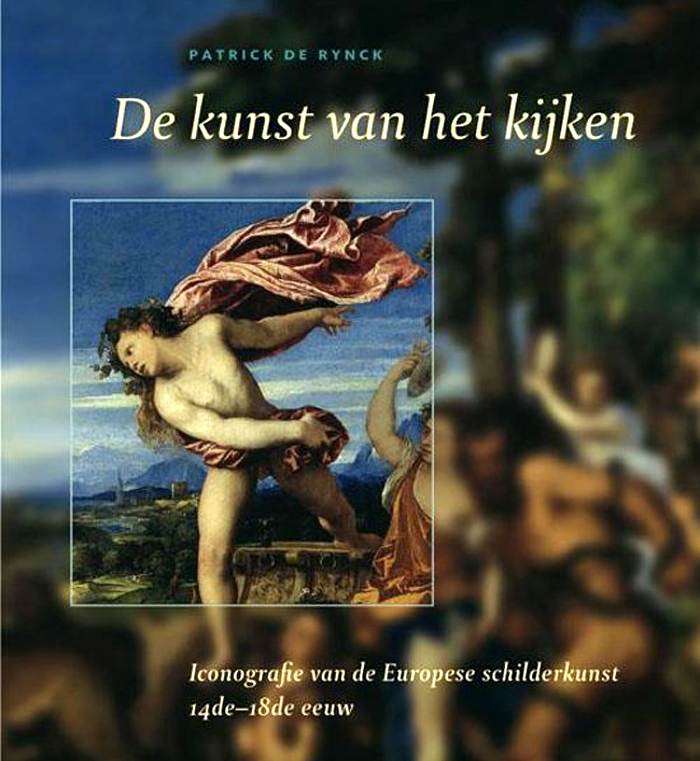“Mérode Triptych / altarpiece”
The Metropolitan Museum of Art, New York (1425-30)
Robert Campin 1375-1445
(and Rogier van der Weyden)
The name Mérode comes from the Belgian noble family, the last private owner before the work became the property of the Metropolitan Museum in 1956. For an altarpiece, it is quite small. This indicates that it was not made for a church, but for private use.
In a recognizable, atmospheric bourgeois interior, Gabriel announces Mary’s pregnancy. The angel has entered quietly; Mary does not look up from her pious reading. She sits humbly on a bench by the fireplace. On the left panel, the kneeling donors witness what is taking place in the room. Behind them stands a city messenger from Mechelen.
♦ On a beam of light, a small child descends carrying a little wooden cross, a reference to Mary’s virginal motherhood and the crucifixion of her son.
(‘Christ immediately became a complete human being, perfect in soul and body. That body possessed all its essential features, but was so small that they were scarcely visible to human eyes.’)
Ludolf of Saxony, Carthusian monk (1300–1378)
♦ Several realistic objects symbolically refer to Mary’s purity, such as the lilies in the Florentine majolica vase, but also the white towel and the water kettle. The coming of Christ will cleanse the world of sin. The light of the candle on the table, and also near the fireplace, has just been extinguished; the flame is a symbol of God, and another form of God is already on the way along the rays of light.
Not all objects in the interior are laden with meaning: some simply have an anecdotal and/or decorative function.
♦ The folds of her garment form a star: Mary as a star among stars. The two books probably represent the Old and New Testaments.
♦ Joseph is working with concentration in his workshop and notices nothing of the miracle taking place in the room next door. The two mousetraps on the workbench and on the display table by the window allude to a statement by Church Father Augustine: ‘The cross of Christ is the devil’s mousetrap; the death of the Lord is the bait by which he was caught.’
In other words: Christ’s death meant the end of the devil.
Joseph played an important role in deceiving the devil: as Mary’s husband and an ordinary mortal, he ensured that Satan could not suspect that the child in her womb was the Son of God.
♦ The left panel shows the patron of the work, kneeling as though he were witnessing the Annunciation on the central panel. This patron was Peter Engelbrechts (or Ingelbrechts) from Mechelen.
In 1420 he married Gretgin Schrinmechers, both of whom came from wealthy families.
His wife was probably added later, after their marriage. The same applies to the man at the gate.
X-ray examination has shown that the brushwork closely resembles that of Campin’s pupil Rogier van der Weyden. It is therefore likely that he painted this panel
♦ Campin created this triptych while he was still living in Tournai. Perhaps that is the medieval town visible in the background.
Source: Patrick de Rijnck
The Art of Looking
Campin, Robert — Mérode Triptych
References
The Art of Looking
14th–18th Century
Patrick de Rynck Photos
Wikipedia
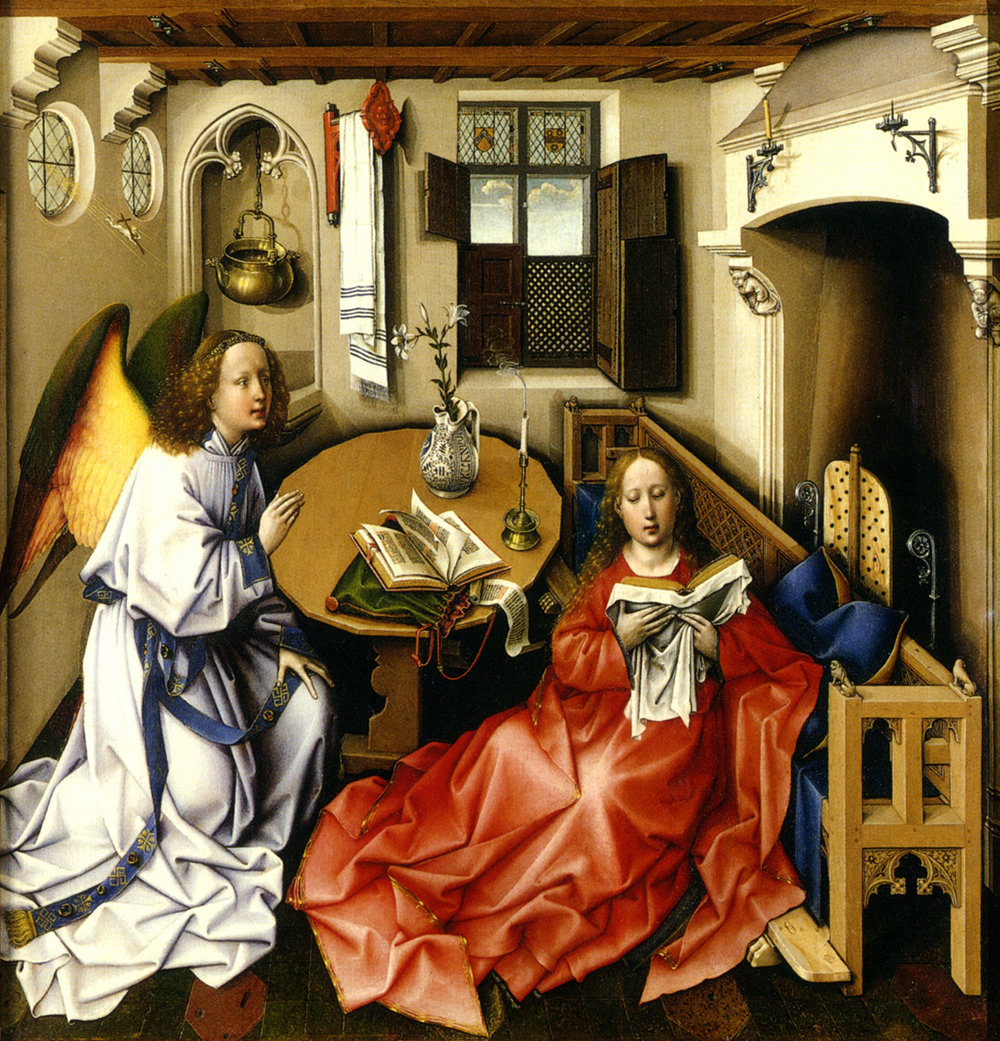
Art lijst
Schilderijen
- Bosch, Hieronymus – The Peddler
- Bosch, Hieronymus_The Haywain triptych
- Botticelli, Sandro_Primavera / Spring
- Brueghel the Elder, Pieter – The Tower of Babel
- Campin, Robert — Mérode Triptych
- Courbet, Gustave_The painters Studio
- Dali, Salvadore_The Temptation of Saint Anthony
- Dou, Gerard_de Kwakzalver
- Eyck van Barthélemy_Stilleven met boeken
- Fra Angelico_Annunciatie
- Géricault, Théodore_Vlot van Medusa
- Magritte, Rene_Verboden af te beelden
- Matsys, Quinten_De geldwisselaar en zijn vrouw
- Memling, Hans_Twee paarden in een landschap
- Onbekend-16e eeuw_4 gedaantes van een arts
- Picasso, Pablo_Guernica
- Rembrandt_Abraham en de drie engelen
- Rembrandt_Elsje Christiaens
- Velazquez, Diego_Las Meninas
Schilderijen en de dokter
- Agenesia Sacrale (a rare congenital disorder in which the fetal development of the lower spine)
- Alopecia areata (hair loss)
- Arthrogryposis congenita (birth defect, joints contracted)
- Artritis psoriatica (inflammatory disease of the joint)
- Artritis reumatoïde
- Breast development (delayed)
- Bubonic plague
- Difterie (kroep)
- Gigantisme & Acromegalie
- Hazenlip (cheiloschisis) / gespleten gehemelte
- Herpes zoster (gordelroos)
- Hongeroedeem
- Influenza Epidemic of 1858
- Keisnijding
- Krankzinnigheid - Malle Babbe (1640)
- Kropgezwel (struma)
- Lepra
- Liefdesziek, zwangerschap
- Lymfkliergezwel (lymfoom), non-Hodgekin
- Manische Depressie Psychose
- Mazelen? / Rubeola? (acute virale infectie)
- Melanoom of naevus (geboortevlek)
- Membraneuze glomerulonefritis
- Moord (pneumothorax, slagaderlijke bloeding)
- Neurofibromatose
- Oogoperatie
- Osteoartrose / hallux valgus
- Osteomyelitis
- Otitis media (acute middenoorontsteking)
- Parotitis (mumps)
- Platvoet en Spitsvoet
- Polio
- Prepatellaire bursitis
- Progeria
- Pseudohermafroditisme
- Pseudozwangerschap
- Psychoneurose (acute)
- Rachitische borst
- Reumatische koorts (acute)
- Rhinophyma of knobbelneus
- Rhinophyma rosacea_depressie
- Rhinoscleroma
- Schimmelziekte_Favus
- Syfilis (harde 'sjanker')
- Tandcariërs
- Tuberculose long
- Ziekte van Paget
Schilders
Historie lijst
- 1632-1723_Antonie van Leeuwenhoek
- 1749-1823_Edward Jenner
- 1818-1865_Ignaz Semmelweis
- 1822-1895_Louis Pasteur
Wetenswaardigheden lijst
- 1887 Psychiatric Hospital
- Animals on duty
- Bizarre advice for parents
- Bloodletting
- Bloodthirsty Hungarian Countess Elizabeth Báthory (1560–1614)
- Butler escaped punishment three times.
- Dance mania / Saint Vitus Dance
- Doctors’ advice did more harm than good
- French Revolution Louis XVI
- Frontal syndroom (Phineas Gage)
- Heart disease (Egyptian princess)
- IJstijd (kleine)_1300-1850
- Ivan IV de Verschrikkelijke (1530-1584)
- Kindermishandeling
- Koketteren met koningin Victoria
- Koningin door huidcrème vergiftigd
- Kraambedpsychose (Margery Kempe)
- Massacre in Beirut
- ME stonden bol van de seks
- Mummie bij de dokter
- Plee, Gemak of Kakstoel
- Prostaatkanker (mummie)
- Sexhandel in Londen
- Swaddling baby
- Syfilis was in de mode
- Testikels opofferen
- Tropische ziekten werden veroveraars fataal
- Vrouwen als beul in WOII
- Wie mooi wil zijn moet pijn lijden
- Zonnekoning woonde in een zwijnenstal

